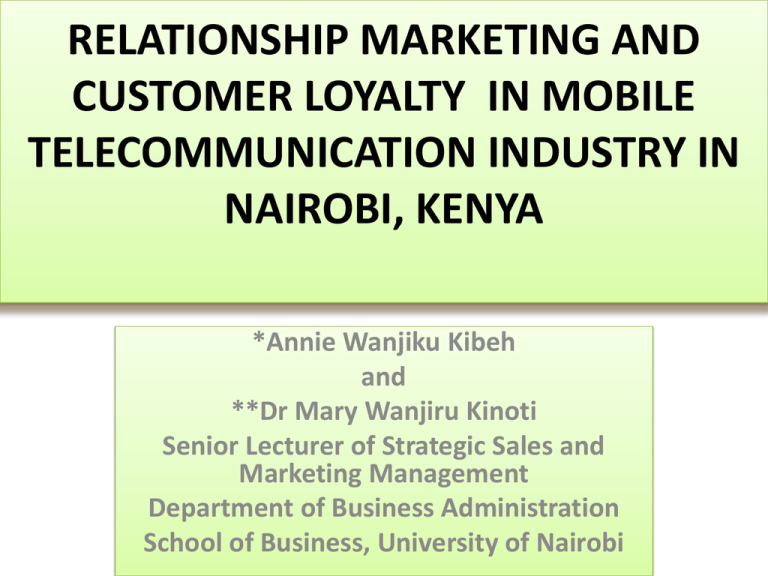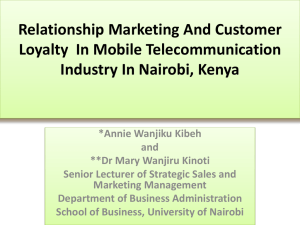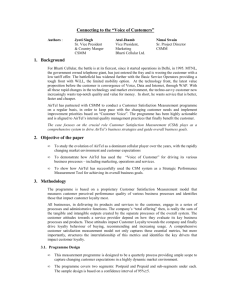relationship marketing and customer loyalty in mobile
advertisement

RELATIONSHIP MARKETING AND CUSTOMER LOYALTY IN MOBILE TELECOMMUNICATION INDUSTRY IN NAIROBI, KENYA *Annie Wanjiku Kibeh and **Dr Mary Wanjiru Kinoti Senior Lecturer of Strategic Sales and Marketing Management Department of Business Administration School of Business, University of Nairobi INTRODUCTION • As the competitive environment becomes more turbulent, the most important issue the sellers face is no longer to provide excellent, good quality products or services, but also to keep loyal customers who will contribute long-term profit to organizations (Tseng, 2007). •To compete in such competitive and interactive marketplace, marketers are forced to look beyond the traditional 4Ps of marketing strategy for achieving competitive advantage. •Therefore, relationship marketing among other marketing strategies have become an alternative means for organizations to build strong, on going associations with their customers (Andaleeb, 2006). •The development of relationship marketing has received a lot of attention in both academia and practice in the last few decades. Indeed relational marketing began to dominate the marketing field in the last decade of the twentieth century (Egan, 2001). •Fundamental reason for companies to build relationships with customers is economic in nature with a view to survive in the global market where customers, are highly sophisticated, educated, confident and informed (Cook, 2011). Relationship Marketing and Customer Loyalty • According to Berry (1995), Relationship marketing orientation measures the extent to which a company engages in developing a long term relationship with its customers. Relationship marketing orientation is a multi-dimensional constructs consisting of five behavioral components: Trust; Commitment; Communications; reprocity, and Satisfaction. • The ultimate goal of RM is to sustain already strong relationships and convert indifferent customers into loyal ones (Ndubisi and Chan, 2005; Ndubisi, 2007). •RM is considered an effective strategy, not only for promoting loyalty and retaining customers, but is also crucial in moving target customers up the ladder of loyalty (Payne et al., 1995). •RM brings stability and decrease uncertainty to the company by acting as a barrier to competitors entry and by keeping a stable and solid base of customers (Newell, 2009). For customers, close and long-term relationships yield three types of benefits: 1) psychological or social benefits (familiarity, friendship and information-sharing), 2) economic benefits (discount or other moneysaving benefits) and 3) customization benefits (tailor-made services/products), as noted by Otim and Grover (2006), Research Methodology •The study employed a descriptive survey, the design was preferred because very large samples can be used, making the results statistically significant. •The population of study comprised 2.4 million mobile users in Nairobi. Essar's mobile service provider Yu brand with market share of 6.3 per cent, Orange Kenya's 10.8 per cent, Airtel Kenya, 22.9% and Safaricom 60% (Economic report 2012) •A sample size of 384 respondents was arrived at by calculating the target population of 2.4million with a 95% confidence level and an error of 0.05. •The study used two sampling techniques namely; stratified proportionate sampling technique. •Dividing the population into a series of relevant strata means that the sample is more likely to be representative (Saunders et al., 2007). Table 1: Sample distribution Name of the Market share in % company Proportionate Sample Safaricom 60 230 Airtel 22.9 88 Orange 10.8 41 Yu-Essar 6.3 24 Primary data was collected using a semi-structured questionnaire which was administered by the researcher and research assistants. •The sampling points were the companies' customer care centers within Nairobi CBD •Descriptive statistics technique were used to analyze the quantitative data while simple multiple regression was used to determine the relationship between the four elements of relationship marketing and customer loyalty. FINDINGS AND RESULTS • Demographic data showed that 56% were males and 44% were females. • Majority of the respondents that participated in the study 42% were between the age of 18 and 28 years of age, followed by those aged between 2838 years with a percentage of 30%. Ages 38-48 were 13% while 48 years and above were 10%. • Of the total respondents 51% indicated that they were connected to Safaricom Ltd, 24% were connected to Airtel Kenya, 16% were connected to Orange Telkom Kenya, 10% were connected to Essar Yu. 6 Communicati 0.203 0.074 0.244 on Reciprocity Satisfaction Word 4.65 0.00 .781 5 0.184 0.044 0.199 0.049 0.387 of0.162 0.056 0.143 mouth 1.333 0 2.89 0.00 .879 6 1.327 0 7.21 0.00 0.750 9 1.280 0 3.72 0.00 .754 8 0.333 5 1.137 4 a Dependent Variable: Customer Loyalty R Square = 0.525 F Statistic= 21.707 Adjusted R Square = 0.515 Sig F Square= 0.000 Predictors in the Model: (Constant), Reciprocity, Trust, Communication, Commitment, Satisfaction Regression results • The effects of the study variables on customer loyalty are shown in the Table 3 above; the R-square 52.5% is adjusted for potential errors to 51.5%. This means that the joint effect of trust, commitment, communication, Reciprocity, satisfaction and word of mouth, predict 51.5% of the variance in customer loyalty. However, the greatest predictor of the variation in relation to the magnitude of the Beta Coefficient is satisfaction (Beta =0.333, t = 7.219, sig = 0.000), followed by communication (Beta = 0.203, t = 4.655, sig = 0.000), reciprocity (Beta = 0.184, t = 3.728, sig = 0.000 and While trust takes the lowest (Beta =0.138, t = 2.363, sig = 0.000). • The F-Statistic (21.707, sig = 0.000) also shows that these variables are statistically significant predictors. This implies that all the variables were important in determining customer loyalty conclusion • In general, this study looked at the relationship between customer relationship marketing and customer loyalty in the mobile telecommunication industry in Kenya. • In particular, the study examined the relationships between the study variables namely; trust, commitment, reciprocity, satisfaction and word of mouth communication. All the relationships were significantly positively related. It is evident that from the study that relationship marketing when emphasized lead to repeat purchases and consumer loyalty. Recommendation • Effective communication between the service provider and the consumer is essential in influencing the trust, satisfaction and subsequently customer loyalty to the firm. • The organizations should also reciprocate to the customers as it is a key driver to customer loyalty. • Finally the study recommends that firms ensure customer satisfaction as it is a good predictor of future purchase behavior, an indication of behavioral loyalty, and profitability of the company.









